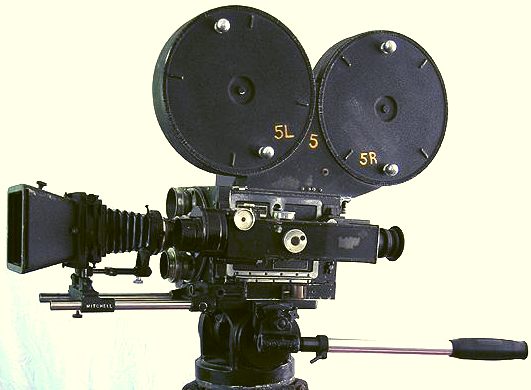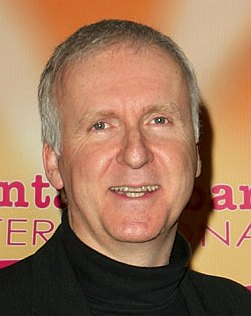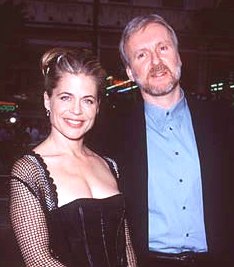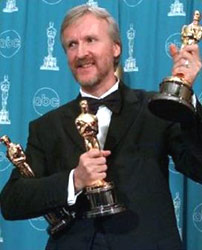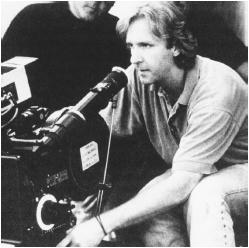|
|
||||||||
|
James Francis Cameron (born August 16, 1954) is a hugely successful three-time Academy Award winning director, producer and screenwriter. He is noted for his action/science fiction films, which are often highly successful financially and innovatively. Thematically, James Cameron's films generally explore the relationship between man and technology. Cameron also directed the film Titanic, which went on to become the top-grossing film of all time, with a worldwide gross of over US$1.8 billion; he also created The Terminator franchise.
James Francis Cameron
Background
James Cameron was born in Kapuskasing, Ontario, Canada, to Phillip, an electrical engineer, and Shirley Cameron, an artist. He grew up in Chippawa, Ontario, and in 1971 his family moved to Brea, California. There he studied physics at Cal State-Fullerton, but his passion for filmmaking would draw him to the film archive of UCLA at every opportunity. After seeing the film Star Wars, Cameron quit his job as a truck driver to enter the film industry.
Early career
He started in the film industry as a screenwriter, then moved into art direction and effects for films such as Battle Beyond the Stars and Escape from New York. Working with producer Roger Corman, Cameron landed his first directorial job in 1981 for the film Piranha II: The Spawning, shot at Grand Cayman Island for the underwater diving sequences, and in Rome, Italy for most of the interior scenes. He was originally hired as the special effects director (and his hand in story-writing can be suspected under the H. A. Milton pseudonym on the original script), and took over the direction when the original director left.
Major films
The Terminator
During his stay in Rome, he fell ill and had a nightmare about a machine emerging from the fire, which had been sent from the future to kill him. While recovering, Cameron materialized the idea for The Terminator. He finally completed a screenplay, and decided to sell it so that he could direct the movie. However, the production companies he contacted, while expressing interest in the project, were unwilling to let a first-time director make the movie. Finally, Cameron found a company called Hemdale Pictures, which was willing to let him direct. His soon-to-be-then-wife, Gale Anne Hurd, who had started her own production company, Pacific Western Productions, had previously worked with Cameron in Roger Corman's company and agreed to buy Cameron's screenplay for one dollar, on the condition that Cameron direct the film. Hurd was signed on as producer, and Cameron finally got his first break as director. Orion Pictures would distribute the film.
Initially, for the role of the Terminator, Cameron wanted someone who wasn't exceptionally muscular, and who could "blend into" a normal crowd. Lance Henriksen, who had starred in Piranha II: The Spawning, was considered for the titular role, but when Arnold Schwarzenegger and Cameron first met over lunch to discuss Schwarzenegger playing the role of Kyle Reese, both came to the conclusion that the cyborg villain would be the more compelling role for the Austrian bodybuilder; Henriksen got the smaller part of LAPD detective Hal Vukovich and the role of Kyle Reese went to Michael Biehn. In addition, Linda Hamilton first appeared in this film in her iconic role of Sarah Connor, and later married Cameron.
The Terminator was a box office hit, breaking expectations by Orion Pictures executives that the film would be regarded as no more than a sci-fi film, and only last a week in theaters. The film was low-budget ($6.5 million), but it earned over $38 million domestically.
Linda Hamilton and James Cameron
Rambo: First Blood Part II
During the early 1980s, Cameron wrote three screenplays simultaneously: The Terminator, Aliens, and the first draft of Rambo: First Blood Part II. While Cameron would continue with The Terminator and with Aliens, Sylvester Stallone eventually took over the script of Rambo: First Blood Part II, creating a final draft which differed radically from Cameron's initial version.
Aliens
Cameron next began the sequel to Alien, the 1979 film by Ridley Scott. Cameron would name the sequel Aliens, and would again cast Sigourney Weaver in the iconic role of Ellen Ripley (the sole survivor from the first film). Aliens became a box office success, and Sigourney Weaver received a nomination for Best Actress during the 1986 Academy Awards. In addition, the film and its lead actress made the cover of Time Magazine as a result of its breakthrough feminist themes about women in combat. Following the phenomenal hit of the film, Cameron now had more freedom to make whatever project he wanted.
The Abyss
Cameron's next project stemmed from an idea that had come up during a high school biology class. The story of oil-rig workers who discover otherworldly underwater creatures became the basis of Cameron's screenplay for The Abyss, which cast Ed Harris and Mary Elizabeth Mastrantonio. Made on a budget of about $41 million U.S., it was considered to be one of the most expensive films of its time, and required cutting-edge effects technology. Because much of the film takes place underwater and the technology wasn't advanced enough to digitally create an underwater environment, Cameron chose to shoot much of the movie "reel-for-real," at depths of up to 40 feet. For creation of the sets, an unfinished nuclear power plant was converted, and two huge tanks were utilized. The main tank was filled with 7.5 million gallons of water, and the second 2.5 million gallons. There, the cast and crew would reside for much of the shooting.
The Abyss opened on August 9, 1989 and held the number-one slot at the box office for two weeks. It ultimately earned $85.2 million domestically, $46 million in foreign markets and a mostly lukewarm response from critics. Cameron would later release a special edition version of the film in spring of 1993, restoring deleted scenes, including the film's climax as it had been originally conceived. The film was nominated for four Academy Awards; Best Visual Effects, Best Art Direction, Best Cinematography, and Best Sound. It won for Best Visual Effects. After the release of The Abyss, Cameron founded his own production company called Lightstorm Entertainment, which produced all of his subsequent films.
Terminator 2: Judgment Day
After the success of The Terminator, there had always been talks about a sequel to continue the story of Sarah Connor and her struggle against machines from the future. Although Cameron had come up with a core idea for the sequel, and Schwarzenegger expressed interest in continuing the story, there were still problems regarding who had the rights to the story, as well as the logistics of the special effects needed to make the sequel. Finally, in mid-1990, Mario Kassar of Carolco Pictures secured the rights to the sequel, allowing Cameron to greenlight production of the film, now called Terminator 2: Judgment Day.
For the film, Linda Hamilton reprised her iconic role of Sarah Connor. In addition, Arnold Schwarzenegger also returned in his role as The Terminator, called the Cyberdyne Systems Model 101, but this time as a protector. Unlike the Model 101, who is made of a metal endoskeleton, the new villain of the sequel, called the T-1000, was a more advanced Terminator made of liquid metal, and with polymorphic abilities. The T-1000 would also be much less bulky than the Model 101. For the role, Cameron cast Robert Patrick, who was a sharp contrast to Schwarzenegger. Cameron explained, "I wanted someone who was extremely fast and agile. If the T-800 is a human Panzer tank, then the T-1000 is a Porsche."
Cameron had originally wanted to incorporate this advanced-model Terminator into the first film, but unfortunately the special effects at the time were not advanced enough. The ground-breaking effects used in The Abyss to digitally realize the water tentacle convinced Cameron that his liquid metal villain was now possible.
TriStar Pictures would distribute the film under a locked release date that was only about half a year away from when shooting would begin. The movie, which was co-written by Cameron and his longtime friend, William Wisher, Jr., had to go from screenplay to finished film in just that amount of time. Like Cameron's previous film, it was one of the most expensive films of its era, with a budget of about $100 million. The biggest challenge of the movie was the special effects used in creating the T-1000. Nevertheless, the film was finished on time, and released to theaters on July 3, 1991.
Terminator 2, or T2, as it was abbreviated, broke box-office records (including the opening weekend record for an R-rated film), earning over $200 million domestically, and over $300 million overseas, and became the highest-grossing film of that year. It won four Academy Awards: Best Makeup, Best Sound, Best Sound Effects, and Best Visual Effects.
James Cameron - Academy Awards
True Lies
Before the release of T2, Schwarzenegger came to Cameron with the idea of making a remake of the French comedy titled La Totale. Titled True Lies, with filming begun after T2's release, the story revolves around a secret-agent spy who leads a double life as a married man, whose wife believes he is a computer salesman. Schwarzenegger would be cast as the secret spy, named Harry Tasker, whose mission in the movie is to investigate and stop a plan by Arab terrorists to use nuclear weapons against the United States. Jamie Lee Curtis would play Schwarzenegger's onscreen wife, with Tom Arnold cast as the secret agent's sidekick.
Cameron's Lightstorm Entertainment signed on with Twentieth Century Fox for production of True Lies. Made on a budget of $115 million and released in 1994, the film earned $146 million in North America, and $232 million abroad.
Titanic
Cameron expressed interest in the famous sinking of the ship Titanic. He decided to script and film his next project based on this event. The picture revolved around a fictional romance story between two young lovers from different social classes who meet onboard the ship's maiden, and final, voyage. Before production began, he took dives to the bottom of the Atlantic and shot actual footage of the ship underwater, which he would insert into the final film.
For the film Titanic, Cameron cast Leonardo DiCaprio, Kate Winslet, and Billy Zane. Cameron's budget for the film reached about $200 million, and it became the most expensive movie ever made. Before its release, the film was widely ridiculed for its expense and protracted production schedule.
Released to theaters on December 19, 1997, Titanic opened with $28 million on its first weekend. The film's grosses escalated in the next several weeks. Titanic was one of very few modern movies to gross more in their second weekend than their first. Its gross increased from $28.6 million to $35.4 million from week 1 to week 2, an increase of 23.8%, unheard of for a wide release, and a testament to the appeal of the movie. This was especially noteworthy, considering that the film's running time of more than three hours limited the number of showings each theater could schedule. It held the #1 spot on the box-office charts for months, eventually grossing a total of over $600 million domestically and more than $1.2 billion outside North America. Titanic became the highest grossing film of all time. (Adjusting for inflation, the film brought in the fifth-highest domestic (U.S. only) gross of all time.) The CG visuals surrounding the sinking and destruction of the ship were considered spectacular. During the 1998 Academy Awards, the film won a record-tying 11 Oscars. Among them were Best Picture and Best Director.
Dark Angel
Cameron had initially next planned to do a film of the comic book character Spider-Man, a project developed by Menahem Golan of Cannon Films. Disputes arose focusing on Golan's role in the Carolco project. A screenplay dating back to 1989 exists with Cameron's name appended to it, indicating he worked with a series of writers on the project (John Brancato, Barry [sic: Barney] Cohen, Joseph Goldmari [sic: "Joseph Goldman" is Menahem Golan's pen name] and Ted Newsom), but the script was identical to one presented to Columbia Pictures by Golan in 1988, where the project had been in development. Subsequently, Cameron presented a 45-page Spider-Man screen story to Carolco, which bore substantive similarities to a number of earlier screenplay drafts, particularly one written by Ethan Wiley (writer of the film House and writer/director of House 2). When Carolco went into bankruptcy, the "Cameron material" (i.e., both the multi-author screenplay and the later treatment credited solely to Cameron) was acquired by MGM. MGM in turn sold them to Columbia Pictures in exchange for Columbia dropping their plans to do an alternative James Bond series based on the Kevin McClory Bond material. Columbia hired David Koepp to adapt Cameron's treatment into a screenplay, and Koepp's first draft is taken often word-for-word from Cameron's story, though it was heavily rewritten by Koepp himself, Scott Rosenberg, Alvin Sargent (husband of producer Laura Ziskin), and (allegedly) Ivan Raimi, brother of director Sam Raimi. Columbia preferred to credit David Koepp solely, and none of the various scripts were ever examined by the Writers Guild of America to determine proper credits. Cameron objected, as did a number of the other writers, but Columbia and the WGA prevailed. The Columbia screenplay was credited solely to Koepp.
Cameron instead moved on to television, and created the story of a new superheroine, which was influenced by cyberpunk, current superhero genres, and third-wave feminism:
Co-produced with Charles H. Eglee, Dark Angel starred Jessica Alba as Max Guevera/X5-452, a genetically enhanced transgenic super-soldier created by the super-secretive Manticore organization. It also starred Michael Weatherly as Logan Cale, and noted actor John Savage (of The Deer Hunter) as Colonel Donald Michael Lydecker. While a success in its first season, low ratings in the second led to its cancellation. Cameron himself directed the series finale, a two-hour episode wrapping up many of the series' loose ends.
AVATAR
In June 2005, Cameron was announced to be working on a project tentatively titled "Project 880" (now known to be Avatar) in parallel with another project, Battle Angel (an adaptation of the manga series Battle Angel Alita). Both movies were to be shot in 3D. By December, Cameron stated that he wanted to film Battle Angel first, followed by Avatar. However in February 2006, he switched goals for the two film projects and decided to film Avatar first. He mentioned that if both films are successful, he would be interested in seeing a trilogy being made for both.
Other projects
Cameron's recent projects have included undersea documentaries on the Bismarck (Expedition: Bismarck, 2002) and the Titanic (Ghosts of the Abyss (2003, in IMAX 3D), and Tony Robinson's Titanic Adventure (2005)). He was a producer on the 2002 film Solaris, and narrated The Exodus Decoded.
Cameron is a leading advocate for stereoscopic digital 3-D films. Ghosts of the Abyss was shot in 3-D, as will his next projects, Avatar, The Dive and an adaptation of the manga series Battle Angel Alita.
Avatar, previously known as Project 880, has an estimated budget of $200 million, is currently in pre-production for a mid-2009 release, and will mark his first feature film since 1997's Titanic. It will be almost entirely composed of computer-generated animation, using a more advanced version of the "performance capture" technique used by director Robert Zemeckis in The Polar Express. Cameron sees Battle Angel Alita as a "three film cycle".
He is also co-rewriting the screenplay for a high-definition 3-D live-action deep-sea-diving drama entitled James Cameron's Sanctum, to be produced by himself and directed by Gary Johnstone. Sanctum will have a relatively-low starting budget of about $20 million.
In addition, he plans to create a 3-D project about the first trip to Mars. ("I've been very interested in the Humans to Mars movement — the 'Mars Underground' — and I've done a tremendous amount of personal research for a novel, a miniseries, and a 3-D film.") He is on the science team for the 2009 Mars Science Laboratory.
Cameron announced on February 26, 2007, that he, along with his director, Simcha Jacobovici, have documented the unearthing of the Talpiot Tomb, which is alleged to be the tomb of Jesus. Unearthed in 1980 by Israeli construction workers, the names on the tomb are claimed, by Cameron, to correlate with the names of Jesus and several individuals closely associated with him. Cameron further claims to have DNA tests, archaeological evidence, and Biblical studies to back up his claim. The documentary, named The Lost Tomb of Jesus, was broadcast on the Discovery Channel on March 4, 2007
Marilyn Manson has made a 3D video for his first single from new album "Eat Me, Drink Me" "Heart Shaped Glasses" which is an extract from a 3D horror movie which Manson will continue filming at the beginning of 2008 with James Cameron. "Heart Shaped Glasses" (previously titled "When the Heart Guides the Hand") can expect to hear around mid April, 2007.
Awards
Cameron received the Bradbury Award from the Science Fiction and Fantasy Writers of America in 1991 — but, being primarily thought of as a genre filmmaker, he did not receive any major mainstream filmmaking awards prior to Titanic. With Titanic, Cameron received the Academy Awards for Best Editing (shared with Conrad Buff IV and Richard A. Harris), Best Picture (shared with John Landau), and Best Director.
In recognition of his contributions to underwater filming and remote vehicle technology, the University of Southampton awarded Cameron the honorary degree of Doctor of the University. Cameron received his degree in person at the graduation ceremony in July, 2004.
FILMOGRAPHY
Writer:
Director:
Miscellaneous Crew:
Editor:
Camera and Electrical Department:
Visual Effects:
Self:
Archive Footage:
James Cameron - Thinking Big
LINKS and REFERNCE
Avatar - Youtube
LINKS:
A - Z FILMS INDEX
A - Z ACTORS INDEX
Lurking beneath the Antarctic ice is a discovery that scientist will die for. This story is now the subject of a low budget film to be produced mostly in the UK. The promoters are looking for backers. The UK will contribute 20% toward production costs. Roughly 60% of a low budget film may be pre-sold as distribution rights. Angels recover 120% on their equity shares within 12 months of shooting, with an income stream thereafter from networks and merchandising. Uncast
|
||||||||
|
This website is Copyright © 1999 & 2013 Max Energy Limited - an educational charity working hard to protect the planet.
|
